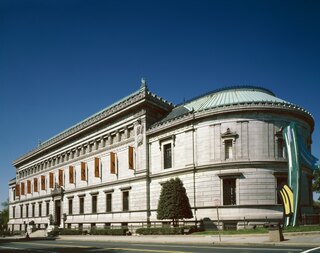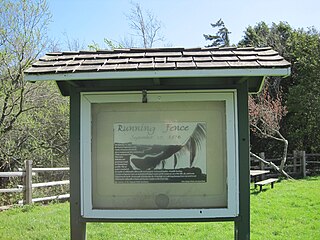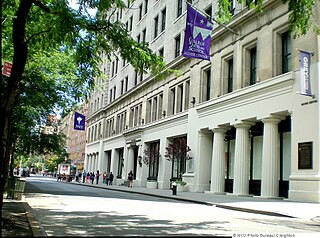Related Research Articles

Land art, variously known as Earth art, environmental art, and Earthworks, is an art movement that emerged in the 1960s and 1970s, largely associated with Great Britain and the United States but that also includes examples from many countries. As a trend, "land art" expanded boundaries of art by the materials used and the siting of the works. The materials used were often the materials of the Earth, including the soil, rocks, vegetation, and water found on-site, and the sites of the works were often distant from population centers. Though sometimes fairly inaccessible, photo documentation was commonly brought back to the urban art gallery.

The Milwaukee Art Museum (MAM) is an art museum in Milwaukee, Wisconsin. Its collection contains nearly 25,000 works of art.

The Corcoran Gallery of Art is a former art museum in Washington, D.C., that is now the location of the Corcoran School of the Arts and Design, a part of the George Washington University.

The Carnegie Museum of Art is an art museum in the Oakland neighborhood of Pittsburgh, Pennsylvania, United States. The museum was originally known as the Department of Fine Arts, Carnegie Institute and was formerly located at what is now the Main Branch of the Carnegie Library of Pittsburgh. The museum's first gallery was opened for public viewing on November 5, 1895. Over the years, the gallery vastly increased in size, with a new building on Forbes Avenue built in 1907. In 1963, the name was officially changed to Museum of Art, Carnegie Institute. The size of the gallery has tripled over time, and it was officially renamed in 1986 to "Carnegie Museum of Art" to indicate it clearly as one of the four Carnegie Museums.

The Gates was a site-specific work of art by Bulgarian artist Christo Yavacheff and French artist Jeanne-Claude, known jointly as Christo and Jeanne-Claude. The artists installed 7,503 steel "gates" along 23 miles (37 km) of pathways in Central Park in New York City. From each gate hung a panel of deep saffron-colored nylon fabric. The exhibit ran from February 12 through February 27, 2005.

Christo Vladimirov Javacheff (1935–2020) and Jeanne-Claude Denat de Guillebon (1935–2009), known as Christo and Jeanne-Claude, were artists noted for their large-scale, site-specific environmental installations, often large landmarks and landscape elements wrapped in fabric, including the Wrapped Reichstag, The Pont Neuf Wrapped, Running Fence in California, and The Gates in New York City's Central Park.
Events from the year 1983 in art.

The Museum of Contemporary Art San Diego (MCASD) is an art museum in La Jolla, a community of San Diego, California. It is focused on the collection, preservation, exhibition, and interpretation of works of art from 1950 to the present.
Dia Beacon is the museum for the Dia Art Foundation's collection of art from the 1960s to the present and is one of the 12 locations and sites they manage. The museum, which opened in 2003, is situated near the banks of the Hudson River in Beacon, New York. Dia Beacon's facility, the Riggio Galleries, is a former Nabisco box-printing facility that was renovated by Dia with artist Robert Irwin and architects Alan Koch, Lyn Rice, Galia Solomonoff, and Linda Taalman, then of OpenOffice. Along with Dia's permanent collection, Dia Beacon also presents temporary exhibitions, as well as public programs designed to complement the collection and exhibitions, including monthly Gallery Talks, Merce Cunningham Dance Company Events, Community Free Days for neighboring counties, and an education program that serves area students at all levels. With 160,000 square feet (15,000 m2), it is one of the largest exhibition spaces in the country for modern and contemporary art.

The National Museum of Wildlife Art (NMWA) is a museum located in Jackson Hole, Wyoming, United States that preserves and exhibits wildlife art. The 51,000 square foot building with its Idaho quartzite façade was inspired by the ruins of Slains Castle in Aberdeenshire, Scotland and echoes the hillside behind the facility. Located on a bluff called East Gros Ventre Butte in the midst of a real wildlife habitat, the institution overlooks the National Elk Refuge and is situated 2.5 miles north of the town of Jackson. The core of the collections reflects traditional and contemporary realism. The museum's centerpiece is a collection of works by Carl Rungius (1869–1959) and Bob Kuhn (1920–2007). In addition to 14 galleries, the museum has a sculpture trail, museum shop, restaurant, children's discovery gallery, and library. More than 80,000 people visit every year, and over 10,000 children visit the museum each year, often as part of their school curricula. The Museum is a nonprofit.

Running Fence was an installation art piece by Christo and Jeanne-Claude, which was completed on September 10, 1976. The art installation was first conceived in 1972, but the actual project took more than four years to plan and build. After it was installed, the builders removed it 14 days later, leaving no visible trace behind.

Founded in 1979, the Aspen Art Museum (AAM) is a leading contemporary art museum located in Aspen, Colorado, United States. It operates as a non-collecting institution, showcasing a diverse program of exhibitions spanning various mediums, such as drawings, paintings, sculptures, multimedia installations, performance art, and electronic media. Dedicated to fostering cultural exchange and transformative ideas, AAM serves as a hub for international artists, scholars, policymakers, and innovators, aiming to shape both the museum landscape and the broader field of art.
Frank Shifreen is an American artist, curator, and teacher. Shifreen played a significant part in the art movement of New York City in the early 1980s, organizing massive artist-run shows that brought thousands of people to Gowanus, Brooklyn. Since then, he has organized socially conscious art exhibitions across the United States and abroad, including From the Ashes, a massive exhibition organized in the aftermath of 9/11. A neo-expressionist and social sculptor, he is a graduate of the Pratt Institute and Adelphi University, he is currently finishing a doctorate in art and art education at the Teachers College at Columbia University.

The Andy Warhol Museum is located on the North Shore of Pittsburgh, Pennsylvania, in the United States. It is the largest museum in North America dedicated to a single artist. The museum holds an extensive permanent collection of art and archives from the Pittsburgh-born pop art icon Andy Warhol.
Kaldor Public Art Projects is an Australian non-profit arts organisation established in 1969 by John Kaldor. The organisation collaborates with international artists to create site-specific art projects in public spaces in Australia.
Marion Gray was an American artist, photographer, and teacher. A vital member of the Bay Area art scene since the 1970s, Gray's "work blurs the lines between documentation and art, and exposes shared approaches between artists working in dance, performance and visual arts." During her long career, Gray documented the performances and works of artists such as John Cage, Christo and Jeanne Claude, Merce Cunningham, Joan Jonas, Marina Abramovic, Meredith Monk, Paul Dresher, Guerrilla Girls, and many others. As curator Christina Linden explains: "her photographs, themselves powerful works of art, constitute an immensely valuable archive of the ephemeral artistic activity the Bay Area has historically fostered.”

The Grey Art Museum, known until 2023 as the Grey Art Gallery, is New York University's fine art museum. As a university art museum, the Grey Art Gallery functions to collect, preserve, study, document, interpret, and exhibit the evidence of human culture. NYU's art collection was named the Grey Art Gallery in 1973 following a major gift of one thousand works from Abby Weed Grey. The museum opened to the public in 1975. The Abby Weed Grey Collection of Modern Asian and Middle Eastern Art at NYU comprises some 700 works produced by artists from countries as diverse as Japan, Thailand, India, Kashmir, Nepal, Pakistan, Iran, Turkey, and Israel.
Surrounded Islands, Biscayne Bay, Greater Miami, Florida, 1980–83 was a 1983 environmental artwork in which artists Christo and Jeanne-Claude surrounded an island archipelago in Miami with pink fabric.

Jan van der Marck was a Dutch-born American museum administrator, art historian, and curator, focused on modern and contemporary art. Van der Marck authored and published many essays, articles and books about artists and art.
References
- ↑ Natalie Haddad (2007-05-23). "Lake Effect". Detroit Metro Times . Archived from the original on 2010-12-15. Retrieved 2012-09-03.
- ↑ Robert del Valle. "Christo and Jeanne-Claude's Gift To Detroit". Real Detroit Weekly . Retrieved 2012-09-03.
- 1 2 3 4 "MONA: A Pop-Up Museum". Archived from the original on 2015-09-23. Retrieved 2012-09-03.
- ↑ Glen Mannisto (2001-12-19). "Oh MONA! The Museum of New Art shoulders the challenge". Detroit Metro Times . Archived from the original on 2016-03-04. Retrieved 2012-09-04.
- ↑ "Lost Warhol to Premiere at Museum of New Art". artdaily. 2006-11-08. Archived from the original on 2008-08-16. Retrieved 2012-09-04.